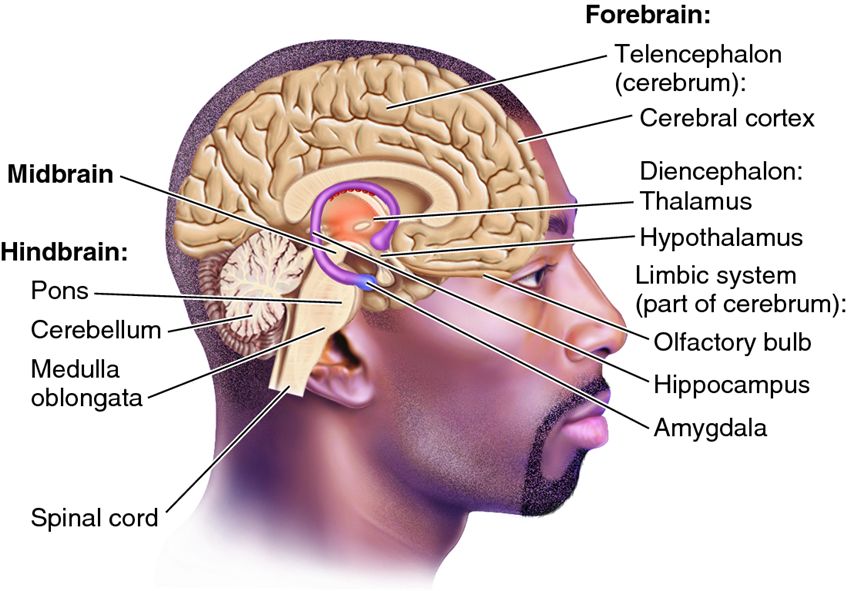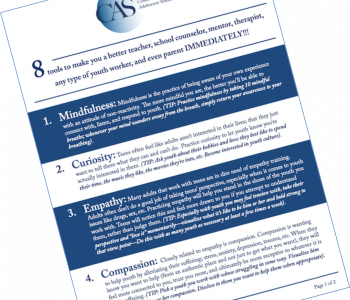

Sam Himelstein, PhD
Sam Himelstein is the founder and CEO of the Center for Adolescent Studies, Inc. He is passionate about working with youth and training the professionals that serve them.
The 4 Essentials of Being a Trauma-Informed Youth Professional
If you work with youth there’s a good chance you work with trauma. Trauma symptoms or adaptations as I like to call them (i.e., your mind/psyche finds ways to adapt to the difficult/dangerous experience for survival) manifest in many ways, from hyper-vigilance to flashbacks, from trust issues to dissociation, from altered world-views to avoiding specific people, places, or even thoughts of course this is not an exhaustive list). Youth from all walks of life can experience trauma. I’ve worked with marginalized youth of color from extremely poor neighborhoods and wealthy white youth with every privilege accessible, and have witnessed trauma manifest in many ways for the above and every population in between. Trauma will arises in your professional role (whether you’re a therapist, educator, counselor, or other youth worker) and it only does disservice to the youth you work with if you’re not aware of, and view youth behavior, through a trauma-informed lens.
It goes without saying that this brief article is simply an introduction, and that those who are truly trauma-informed have skill sets and practice qualities in their professional roles that far outnumber these four essential skill sets.
1) What is trauma and how is it caused?
The first essential in being a trauma-informed youth professional is to understand what trauma is and how it’s caused. The Diagnostic and Statistical Manual of Mental Disorders (currently in its 5th edition), which is the go-to text for mental health professionals, defines trauma as:
Exposure to actual or threatened death, serious injury, or sexual violence in one (or more) of the following ways: 1. Directly experiencing the traumatic event(s). 2. Witnessing, in person, the event(s) as it occurred to others. 3. Learning that the traumatic events(s) occurred to a close family member or close friend. In cases of actual or threatened death of a family member or friend, the event(s) must have been violent or accidental. 4. Experiencing repeated or extreme exposure to aversive details of the traumatic event(s) (e.g., first responders collecting human remains, police officers repeatedly exposed to the details of child abuse). Note: Criterion A4 (the last one) does not apply to exposure through electronic media, television, movies, or pictures, unless this exposure is work related. (DSM 5, p. 271)
While this is a widely used definition of trauma, it’s not without critique. It’s first important to consider that trauma itself isn’t the threatening or dangerous experience. What makes a horrible experience traumatic is how an individual, family, or community responds to it (e.g., that’s why I like the term “adaptation” over symptoms. It speaks to the fact that people respond to trauma and attempt, unconsciously, to adapt and deal with it). The above definition captures a lot of experiences that cause trauma, however falls short in fully encapsulating the complexities of experience outside of single events. For example, it would be a stretch to fit the experience of racism into the above definition, yet there is extensive research supporting the notion that those who have been victims of racist events, ideologies, and institutional regimes can develop symptoms of trauma.
One of the most important studies regarding trauma, especially in youth, is the Adverse Childhood Experiences (ACEs) Study conducted by Dr. Vincent Felitti from Kaiser in collaboration with the Center for Disease Control. Briefly, this study investigated the childhood experiences of approximately 17,000 insured middle and older aged adults and found that folks who had at least 4 ACEs (from a survey asking about 10 ACEs) were much more likely to have a slew of psychological and medical problems that could result in early death. The 10 ACEs surveyed in the original study were:
- Verbal Abuse
- Physical Abuse
- Sexual Abuse
- Emotional Neglect
- Physical Neglect
- Divorce/Parent Separation
- Domestic Violence
- Alcohol/Drug Exposure
- Exposure to Mental Illness and Suicide
- Having A Household Member in Prison
Consider briefly the ACEs of emotional and physical neglect. It would be difficult to position these experiences within the DSM’s definition and yet this is the most common form of abuse reported on youth in the United States and can lead to devastating consequences, one of which is trauma. The ACEs study was foundational in expanding the mental health field’s view of what trauma is and how it’s caused. It did not, however, include an exhaustive list of experiences with the potential to lead to trauma. Other experiences that lead to trauma included (but isn’t limited to):
- War, Terrorism, Mass Shootings
- Refugee Encampment
- Deportation of a family member
- Life Threatening Illness
- Natural and Unnatural Disasters
- Motor Vehicle Accidents
- Community Violence
- Repeated Exposure to Trauma Details
- Relational and Attachment-based trauma and,
- Systemic oppression (racism, classism, sexism, etc.)
An evolving definition that I continue to edit for trauma is (using the DSM’s above definition as a starting point as I am a psychologist by trade):
Trauma is…
A response to actual, perceived, or threatened death, physical violence, sexual violence, neglect, serious injury, catastrophic natural disasters, unhealthy early child relational attachments, racism and/or oppression in one or more of the following ways: 1) Direct experiencing, 2) Witnessing the event(s) happen to someone else, 3) Learning the event(s) happened to a family member, close friend, or member of one’s community, race, sexual orientation, etc., and 4) Repeated exposure to details of the event(s) via social media, images, intrusive thoughts and/or conversation.
I don’t believe this is a perfect definition of trauma, but rather a starting point for dialogue about the different experiences that define what trauma is and how different populations experience it. As the field continuously evolves, it’s my hope this definition will as well. For now, thinking about trauma from an expanded viewpoint like above will help you be a trauma-informed professional.
2) Understand how trauma affects the brain and learning
Another aspect of practicing trauma-informed care is having a basic understanding of how trauma affects the brain. Why? Because this will give you a much deeper insight into the next tip, how trauma affects youths’ behaviors. I wrote about how trauma impacts the brain in another article that you can check out and will summarize here for brevity’s sake.
Basically, the brain can be simplistically categorized into three layers: 1) the hindbrain; evolutionarily the oldest part of our brain that comprises the brain stem and cerebellum, this part of the brain controls our essential functions that we don’t have to think about like breathing, heart beating, etc. Next is the mid-brain, also sometimes known as the emotional brain or emotional center. This is the limbic system and is comprised of the amygdala (our fear center), the hippocampus (which has to do with memory), the thalamus (which absorbs sensory information), and the hypothalamus (the messenger between the midbrain and hindbrain. Finally, the most recent layer of the brain from an evolutionary perspective is the forebrain. We share this (and the midbrain) with other mammals, but our forebrain is comparatively bigger than other mammals. This is the part of the brain responsible for language, abstract though, perspective-taking, and executive function.

Essentially, the take home point for how trauma effects the brain is that the thalamus absorbs sensory information (let’s say a person walking toward you with a knife), the amygdala (think of this as the alert system) interprets danger (DANGER, DANGER, DANGER sirens go off), the hypothalamus then connects directly with the autonomic nervous system via the hindbrain and triggers you into fight, flight, or freeze (we’ll go into these in depth in another post) mode and essentially all communication to your forebrain (the thinking, deciding, logical brain) gets cut off. That’s why when someone is experiencing danger, or triggered trauma, it’s difficult to make decisions, concentrate, and conduct simple executive tasks. If communication to the executive function part of the brain is cut off, how do we think that’ll impact learning and behavior with youth in our classrooms, therapy offices, etc.? Right, it can have a drastic impact and sometimes when a youth in your class is being “defiant” it isn’t always because they just don’t like you or want to disrespect you. It can be because their trauma has been triggered. This understanding is essential for trauma-informed youth professionals.
3) View difficult, disrespectful, and defiant behaviors via a trauma-informed lens
Multiple traumas or even a single traumatic event could contribute to a slew of behavioral traumatic adaptations—that is the behavioral manifestation that the person adopts as a protective mechanisms to cope psychologically with the trauma they’ve experienced. These can be aggressive behaviors like fighting, physical intimidation, or verbal assaults; dissociative behaviors like becoming detached, extremely bored, feeling like reality is a dream, or like one isn’t in their own body; humorous defensive mechanisms, overly compliant behaviors, and much more. They key here is not to over interpret everyone’s behavior as trauma, but rather to consider the possibility that out-of-the-ordinary behaviors stem from trauma (e.g., a youth gets disproportionately angry with you when you ask a simple request; a youth is too compliant or perfectionistic; a youth is very “dazed” and often seems dissociated from their bodies, the present moment, and un-grounded). The general idea is to: 1) leave room for the possibility that an extreme or out-of-the-ordinary behavior from a youth is the result of them protecting themselves psychologically from their trauma and 2) that because this is a form of self-protection, you don’t have to take it personally. If you take defiant, negative, aggressive behaviors as less personal, you will not only do your job much more skillfully and have a better shot at engaging and helping the struggling youth, but also will burnout less and practice much better self-care.
4) Work on yourself and your relationship-building abilities.
4a) Working on yourself:
Your ego will play a big role in how you respond to traumatic adaptions from youth. Remember, these adaptations can show up as resistance, defiance, and any other youth behavior that can make you extremely uncomfortable. How you respond is essential, and this takes practice. Practicing not taking things personally is an art and takes time. For the truly traumatized, the behavior they’re displaying is not about you. You may have triggered it, but it’s about what happened to them and the unfortunate conditioned feedback loop that plays out in their behaviors as a result of it. If you remember that they’re simply trying to protect themselves, you will take it less personally. Let that reminder be your practice, your mantra.
The second piece of working on you is self-care. The above framework is in itself a self-care practice, because it has the potential to prevent a lot of hurt in your life, but other self-care practices include mindfulness, exercise, spending time with friends, reading, going to the movies, or whatever it is you need to do to practice self-care.
4b) Working on relationship building skills:
Alongside the above, what’s most important in engaging traumatized youth is making them feel safe so that they can eventually trust you. How’s that done? The first step is building an authentic relationship. In a past post I overviewed 6 steps to building authentic relationships with youth. Most important to working with traumatized youth is the ego awareness work of setting healthy boundaries and engaging resistance from a place of understanding. Deeply listening to youths’ stories and being genuinely curious about their lives, practicing appropriate self-disclosure to make them feel connected, practicing attunement—i.e., becoming attuned to the physical, mental, and emotional states of being and meeting them there, and of course the simple but powerful intention of just wanting to build a relationship and everything that comprises it; kindness, humor, compassion, and love, also contribute to building authentic relationships.
—
The four essentials in this brief article should be viewed as a starting point for practicing trauma-informed care—this is not an exhaustive list but rather what’s essential for engaging youth from a trauma-informed perspective; whether you’re a psychotherapist, teacher, coach, social worker, mentor, probation professional, or other youth worker.
Related Posts
Compassion Can Help You Work with Trauma-Impacted Youth
A Critical Intervention for Working with Traumatized Youth
3 Ways Traumatic Events in the Lives of Teens Impact Substance Abuse
4 “Must Read” Books for Professionals Working with Traumatized Youth
Check out the Trauma-Informed Care for Professionals Working with Youth online course for further training.

